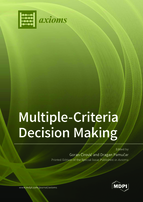Multiple-Criteria Decision Making
A special issue of Axioms (ISSN 2075-1680). This special issue belongs to the section "Logic".
Deadline for manuscript submissions: closed (30 September 2021) | Viewed by 52395
Special Issue Editors
Interests: computational intelligence; Multi-criteria decision making problems; rough set theory; fuzzy set theory; optimization; neuro-fuzzy systems
Special Issues, Collections and Topics in MDPI journals
Interests: multi-criteria decision making problems; computational intelligence; sustainability neuro-fuzzy systems; fuzzy; rough and intuitionistic fuzzy set theory; neutrosophic theory
Special Issues, Collections and Topics in MDPI journals
Special Issue Information
Dear Colleagues,
Decision making on real world problems, including individual process decisions, requires an appropriate and reliable decision support system. Fuzzy set theory, rough set theory and neutrosophic set theory, which are MCDM techniques, are useful for modeling complex decision making problems with imprecise, ambiguous or vague data.
This Special Issue on “Multiple Criteria Decision Making” aims to incorporate recent developments in the area of the multi-criteria decision making field. Topics include, but are not limited to:
- MCDM optimization in engineering;
- Environmental sustainability in engineering processes;
- Multi-criteria production and logistics processes planning;
- New trends in multi-criteria evaluation of sustainable processes;
- Multi-criteria decision-making in strategic management based on sustainable criteria.
Dr. Goran Ćirović
Dr. Dragan Pamučar
Guest Editors
Manuscript Submission Information
Manuscripts should be submitted online at www.mdpi.com by registering and logging in to this website. Once you are registered, click here to go to the submission form. Manuscripts can be submitted until the deadline. All submissions that pass pre-check are peer-reviewed. Accepted papers will be published continuously in the journal (as soon as accepted) and will be listed together on the special issue website. Research articles, review articles as well as short communications are invited. For planned papers, a title and short abstract (about 100 words) can be sent to the Editorial Office for announcement on this website.
Submitted manuscripts should not have been published previously, nor be under consideration for publication elsewhere (except conference proceedings papers). All manuscripts are thoroughly refereed through a single-blind peer-review process. A guide for authors and other relevant information for submission of manuscripts is available on the Instructions for Authors page. Axioms is an international peer-reviewed open access monthly journal published by MDPI.
Please visit the Instructions for Authors page before submitting a manuscript. The Article Processing Charge (APC) for publication in this open access journal is 2400 CHF (Swiss Francs). Submitted papers should be well formatted and use good English. Authors may use MDPI's English editing service prior to publication or during author revisions.
Keywords
- Decision making
- Fuzzy set theory
- Rough set theory
- Neutrosophic set theory
- Sustainable development
- Modeling in engineering
- Sustainable waste management
- Sustainable processes
- Environmental engineering
- Engineering sustainability
Related Special Issue
- Multiple-Criteria Decision Making II in Axioms (11 articles)






